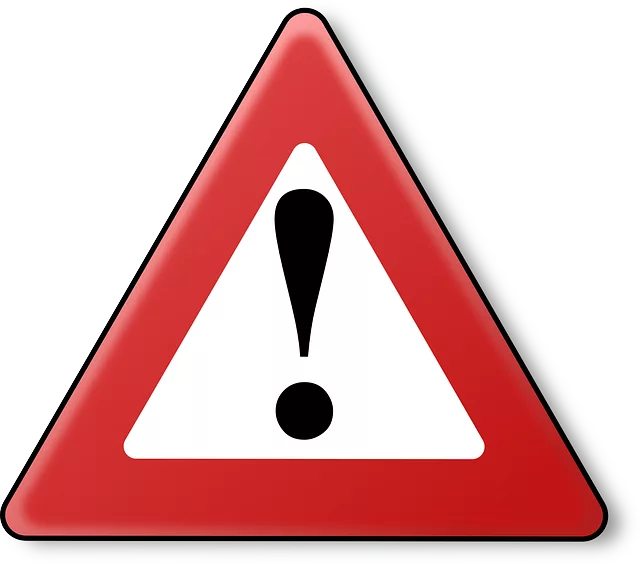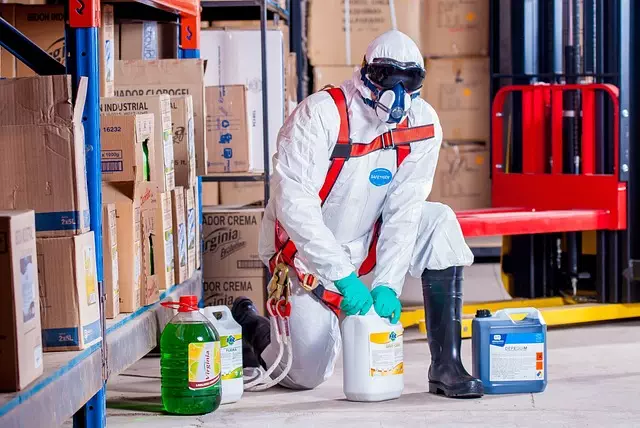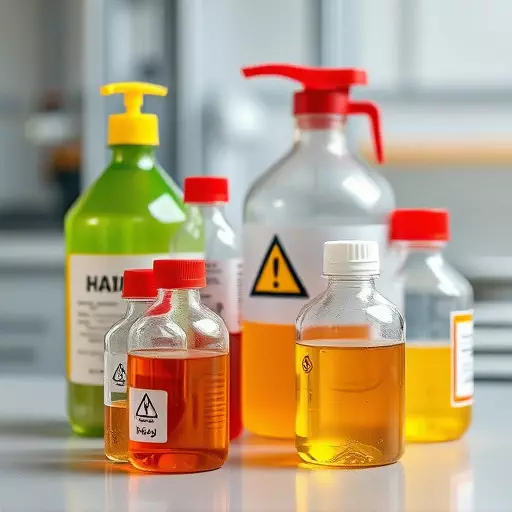Chemical exposure risk management is a multi-faceted process prioritizing worker safety across diverse sectors. It begins with meticulous hazardous material identification using MSDS reviews, labeling systems, and inventory management tools. Rigorous industrial hygiene protocols assess risks, determine exposure levels, and predict health outcomes through methods like air sampling and medical surveillance. Effective control measures, including engineering controls, PPE, and safe work practices, safeguard workers from chemical hazards. Communication strategies utilizing visual aids, role-playing, and written materials ensure worker comprehension of these critical aspects. Case studies demonstrate that robust risk communication and protocols significantly reduce exposure in various industries, leading to improved health outcomes and productivity. Future trends include AI integration for predictive risk analysis and enhanced digital platforms for proactive, collaborative safety culture cultivation.
Chemical exposure risk management is a critical aspect of modern workplace safety, particularly in industrial settings where hazardous materials are prevalent. This comprehensive guide explores various facets of managing and communicating these risks. From understanding industrial hygiene protocols to identifying dangerous substances, we delve into effective training strategies and successful case studies. Additionally, we look at future trends shaping chemical risk communication and regulatory compliance, ensuring a thorough overview for professionals in this domain.
- Understanding Chemical Exposure Risk Management: A Comprehensive Overview
- Industrial Hygiene Protocols: Safeguarding Workers from Hazardous Materials
- Identifying Hazardous Materials: Unveiling Potential Risks in the Workplace
- Effective Communication Strategies for Chemical Safety Training
- Implementing Risk Assessment and Mitigation Measures
- Case Studies: Successful Chemical Exposure Prevention in Industries
- Future Trends in Chemical Risk Communication and Regulatory Compliance
Understanding Chemical Exposure Risk Management: A Comprehensive Overview
Chemical exposure risk management is a critical aspect of ensuring worker safety and maintaining industrial hygiene in various sectors. It involves a comprehensive understanding of identifying, assessing, and mitigating risks associated with hazardous materials in the workplace. The first step in this process is thorough hazardous material identification, where organizations catalog and analyze all chemicals present in their operations. This includes conducting material safety data sheet (MSDS) reviews, implementing proper labeling systems, and utilizing advanced technologies for accurate inventory management.
Once identified, these substances require careful risk assessment to determine potential exposure levels and associated health effects. Industrial hygiene protocols play a pivotal role here, employing methods like air sampling, biological monitoring, and comprehensive medical surveillance programs. By combining these strategies, organizations can effectively manage risks, establish safety standards, and implement control measures to protect workers from the harmful effects of chemical exposure.
Industrial Hygiene Protocols: Safeguarding Workers from Hazardous Materials
Industrial Hygiene protocols are vital for managing chemical exposure risk and safeguarding workers from hazardous materials. These protocols involve a comprehensive approach to identify, assess, and control potential risks associated with chemicals in the workplace. By implementing rigorous procedures, organizations can ensure that employees are protected against harmful substances, fostering a safer work environment.
Effective industrial hygiene practices begin with thorough hazardous material identification. This involves conducting detailed surveys, reviewing safety data sheets (SDS), and utilizing specialized tools to detect and characterize chemical hazards present. Once identified, these materials require appropriate risk assessment methods to determine their potential impact on workers’ health. Based on the assessment, targeted control measures can be implemented, such as engineering controls, personal protective equipment (PPE), and safe work practices, to minimize or eliminate chemical exposure risks.
Identifying Hazardous Materials: Unveiling Potential Risks in the Workplace
Identifying hazardous materials is a critical step in managing chemical exposure risk in the workplace. This process involves thorough assessments and following established industrial hygiene protocols to uncover potential risks lurking within work environments. By implementing rigorous hazardous material identification techniques, organizations can ensure they are aware of all substances present, their properties, and associated dangers.
Effective identification requires comprehensive training for employees, utilizing resources such as Material Safety Data Sheets (MSDS) and proper labeling systems. This ensures that everyone is equipped to recognize potential hazards, understand safety precautions, and respond appropriately in case of an emergency. Regular audits and inspections further reinforce the importance of adhering to industrial hygiene standards, ultimately fostering a safer working atmosphere.
Effective Communication Strategies for Chemical Safety Training
Effective communication is key to managing chemical exposure risk and ensuring the safety of workers in any industrial setting. When conducting chemical safety training, it’s crucial to employ strategies that cater to different learning styles and ensure comprehension. Visual aids such as infographics and diagrams can help illustrate hazardous material identification, making complex information more accessible.
Interactive sessions, including role-playing scenarios, allow trainees to apply their knowledge of industrial hygiene protocols in practical situations. This hands-on approach enhances understanding and encourages active participation. Additionally, providing clear, concise written materials complements these activities, offering a comprehensive reference for future reference and review.
Implementing Risk Assessment and Mitigation Measures
Implementing effective risk assessment and mitigation measures is paramount in managing chemical exposure risk. This involves a systematic approach to identify and evaluate potential hazards associated with hazardous materials in industrial settings. By conducting thorough hazard assessments, organizations can pinpoint specific risks posed by various chemicals, including their toxicological profiles, physical properties, and potential routes of exposure. These assessments lay the foundation for developing tailored industrial hygiene protocols that prioritize worker safety.
Once identified, hazardous materials require appropriate management strategies to minimize risk. This includes implementing strict handling procedures, providing personal protective equipment (PPE), and ensuring proper ventilation to control chemical exposure. Regular monitoring and training sessions further reinforce a culture of safety, empowering employees to recognize and respond to potential risks effectively. Adhering to these measures significantly reduces the likelihood of accidents, health issues, and overall exposure to harmful chemicals, fostering a safer work environment.
Case Studies: Successful Chemical Exposure Prevention in Industries
Case studies highlight the power of effective chemical risk communication in various industries. For instance, a successful implementation of industrial hygiene protocols at a major manufacturing plant demonstrated significant reductions in chemical exposure risk. By employing rigorous hazardous material identification processes, the company identified and minimized risks associated with toxic substances present in their production lines. This proactive approach involved comprehensive training programs for workers, regular monitoring of air quality, and the adoption of innovative engineering controls to ensure a safer working environment.
The results were remarkable: a decrease in respiratory issues among employees and a substantial drop in overall chemical exposure levels. Such success stories underscore the importance of clear communication about chemical hazards, proper safety protocols, and continuous improvement in industrial hygiene practices across different sectors. Effective risk management strategies not only protect workers’ health but also enhance productivity by fostering a culture of safety and well-being within industrial settings.
Future Trends in Chemical Risk Communication and Regulatory Compliance
As we move forward into a more digitally connected world, future trends in chemical risk communication and regulatory compliance are expected to evolve significantly. One key area is the integration of advanced technologies like artificial intelligence (AI) and machine learning for more accurate hazardous material identification. These tools can analyze vast data sets from various sources, including environmental sensors, industrial hygiene protocols, and historical incident reports, to predict and mitigate chemical exposure risks in real-time.
Another notable trend is the shift towards a more proactive approach in risk management. This involves not just reacting to potential hazards but also anticipating them through improved communication channels and transparent data sharing among stakeholders. Enhanced digital platforms will facilitate better collaboration between regulatory bodies, manufacturers, and end-users, ensuring that everyone stays informed about updated industrial hygiene protocols and emerging chemical risks. This collaborative ecosystem aims to foster a culture of safety where chemical exposure risk management is prioritized at all levels, from research and development to workplace implementation.


